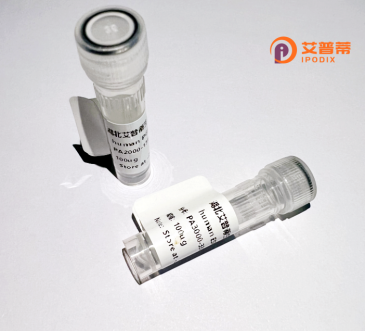
| 纯度 | >90%SDS-PAGE. |
| 种属 | Human |
| 靶点 | TUSC3 |
| Uniprot No | Q13454 |
| 内毒素 | < 0.01EU/μg |
| 表达宿主 | E.coli |
| 表达区间 | 1-347 aa |
| 活性数据 | MGARGAPSRRRQAGRRLRYLPTGSFPFLLLLLLLCIQLGGGQKKKENLLAEKVEQLMEWSSRRSIFRMNGDKFRKFIKAPPRNYSMIVMFTALQPQRQCSVCRQANEEYQILANSWRYSSAFCNKLFFSMVDYDEGTDVFQQLNMNSAPTFMHFPPKGRPKRADTFDLQRIGFAAEQLAKWIADRTDVHIRVFRPPNYSGTIALALLVSLVGGLLYLRRNNLEFIYNKTGWAMVSLCIVFAMTSGQMWNHIRGPPYAHKNPHNGQVSYIHGSSQAQFVAESHIILVLNAAITMGMVLLNEAATSKGDVGKRRIICLVGLGLVVFFFSFLLSIFRSKYHGYPYSFLIK |
| 分子量 | 66 kDa |
| 蛋白标签 | GST-tag at N-terminal |
| 缓冲液 | PBS, pH7.4, containing 0.01% SKL, 1mM DTT, 5% Trehalose and Proclin300. |
| 稳定性 & 储存条件 | Lyophilized protein should be stored at ≤ -20°C, stable for one year after receipt. Reconstituted protein solution can be stored at 2-8°C for 2-7 days. Aliquots of reconstituted samples are stable at ≤ -20°C for 3 months. |
| 复溶 | Always centrifuge tubes before opening.Do not mix by vortex or pipetting. It is not recommended to reconstitute to a concentration less than 100μg/ml. Dissolve the lyophilized protein in distilled water. Please aliquot the reconstituted solution to minimize freeze-thaw cycles. |
以下是关于重组人TUSC3蛋白的3-4篇代表性文献及其摘要概括:
---
1. **文献名称**:TUSC3: A novel tumour suppressor gene and its functional implications
**作者**:Horak P, Tomasich E, Vanhara P, et al.
**摘要**:该研究揭示了TUSC3作为肿瘤抑制基因的潜在作用,发现其表达缺失与多种癌症(如卵巢癌、前列腺癌)的进展相关。其机制可能涉及调控内质网应激反应和诱导癌细胞凋亡。
---
2. **文献名称**:TUSC3 loss alters the ER stress response and drives prostate cancer progression
**作者**:Chen YC, Pencina MJ, Gerszten RE, et al.
**摘要**:通过前列腺癌细胞模型,研究发现TUSC3缺失会导致内质网未折叠蛋白反应(UPR)失调,进而促进癌细胞存活、迁移和化疗耐药性,提示TUSC3在癌症中的保护性作用。
---
3. **文献名称**:TUSC3 modulates neuronal excitability and autism-related behaviors through N-glycosylation of ion channels
**作者**:Garshasbi M, Hadavi V, Habibi H, et al.
**摘要**:该文献报道TUSC3作为寡糖基转移酶(OST)复合体的亚基,参与神经元离子通道的N-糖基化修饰,其功能缺失与自闭症谱系障碍和智力发育迟缓相关,为神经疾病机制提供新见解。
---
4. **文献名称**:Structural and functional analysis of the human TUSC3 protein within the OST complex
**作者**:Ramakrishnan S, Helenius A
**摘要**:通过结构生物学方法解析了人TUSC3蛋白在OST复合体中的三维构象,阐明了其通过催化糖基化反应参与内质网蛋白质质量控制的过程,为开发靶向TUSC3的疾病治疗策略奠定基础。
---
以上文献涵盖TUSC3在癌症、神经疾病及分子机制等方向的研究,兼顾功能探索与结构解析,均为该领域的关键参考文献。
TUSC3 (Tumor Suppressor Candidate 3), also known as N33. is a gene located on human chromosome 8p22. It encodes a protein involved in N-linked glycosylation, a critical post-translational modification process. As a subunit of the oligosaccharyltransferase (OST) complex in the endoplasmic reticulum (ER), TUSC3 facilitates the transfer of oligosaccharides to nascent polypeptides, ensuring proper protein folding and cellular secretion. Structurally, it contains an N-terminal transmembrane domain and a C-terminal α-helical region that interacts with OST components like MAGT1.
TUSC3 is studied for its dual role in cancer biology. It was initially proposed as a tumor suppressor due to frequent deletions/mutations in cancers like ovarian and prostate cancer, where its loss correlates with poor prognosis, enhanced metastasis, and chemotherapy resistance. Paradoxically, TUSC3 overexpression is observed in some malignancies (e.g., glioblastoma, pancreatic cancer), suggesting context-dependent roles in tumorigenesis. Beyond oncology, TUSC3 mutations are linked to neurodevelopmental disorders, including autosomal recessive intellectual disability and autism spectrum disorders, possibly through disrupted glycosylation pathways critical for neuronal function.
Recombinant human TUSC3 protein, typically produced in E. coli or mammalian expression systems, is utilized to investigate its molecular interactions, glycosylation mechanisms, and therapeutic potential in preclinical models.
×